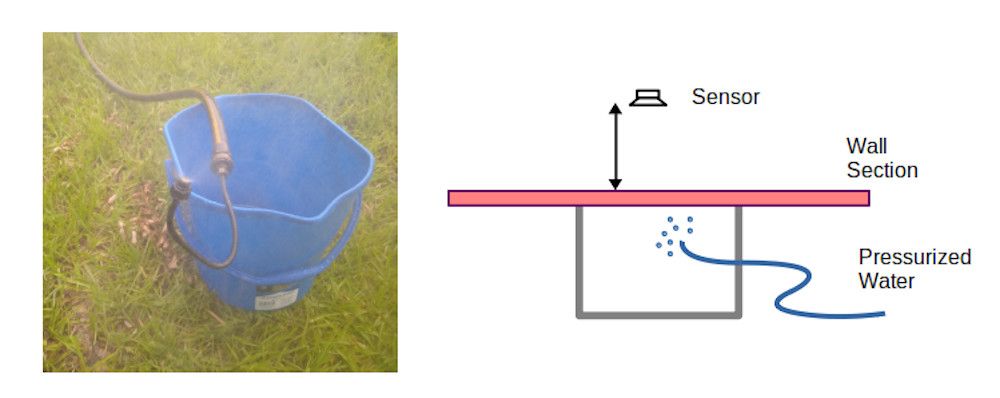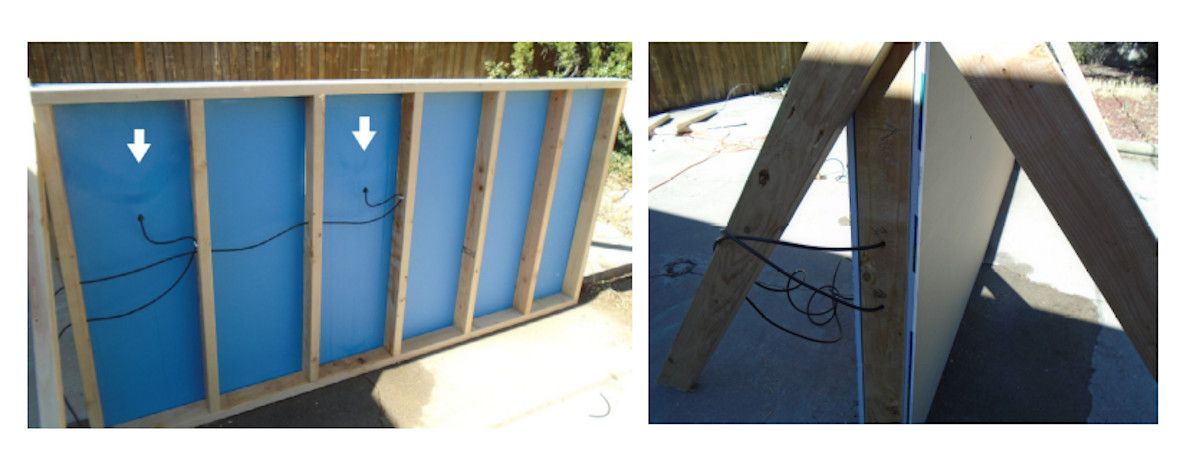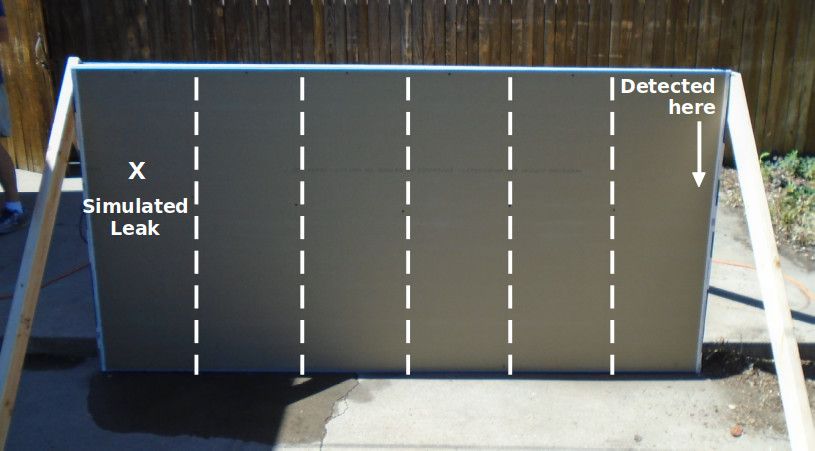Project update 6 of 11
Detecting Leaks Behind Walls
by Mike HThis update describes some measurements that helped establish the AquaPing’s capability to detect water leaks behind walls. This question is relevant for many security, plumbing, and insurance/loss prevention applications. But, to give a good answer, we need data from well designed experiments.
To simulate leaks, we used garden irrigation foggers (Home Depot 7760F) specified to flow at 0.04 gpm in a ~ 90° pattern (photo below, left). Timed measurements with a graduated cylinder confirmed the flow rate. Although not representative of all possible leaks, these water misters produce a broadband acoustic signal ideal for the frequencies targeted by the AquaPing.
Tests were done to characterize the acoustic attenuation introduced by various wall materials when in the path between the simulated leak and the sensor. The leak source is placed in a square plastic vessel to confine lateral sound propagation (see right diagram above). The cross-sectional dimensions of the test boards are about three times larger than the container, assuring that the sensor only receives acoustics propagating through the board, not around it. The leak is located ~15 cm below the bottom surface of the wall section. Because the leak is completely enclosed, its signal may be amplified by reflections from inside the container.
Four different wall materials were tested; results are summarized in the following table. Although the standoff detection distance is significantly reduced compared to a free-space path (> 10 m), the AquaPing is still able to reliably detect the simulated leak when it is positioned sufficiently close to the wall surface. Note the expected increased attenuation with thicker test sections.
| Wall Test Material | Maximum Standoff Detection Distance |
|---|---|
| 1⁄2 in. drywall | 56-61 cm |
| 1⁄2 in. drywall + 1 in. foam insulation layer | 43-cm |
| 1⁄4 in. plywood | 71-76 cm |
| 1⁄2 in. plywood | 43-46 cm |
The next step is to assess sensor performance with a wall structure that resembles an anticipated use case. A test wall was constructed on a 4 x 8 ft (1.22 x 2.44 m) frame consisting of six internal sections defined by 2 x 4 in. studs on the US standard of 16 in. (40.64 cm) on center.
External bracing is added along with two irrigation foggers attached to the inside of the structure. The black plastic feeder lines are held in place on the joists with staples. Separate valves allow the misters to be independently activated at a pressure provided by the water utility. The frame is enclosed by screwing on two sections of water-repellent drywall, with the blue, coated surface facing inward.
This video clip shows one of the simulated leaks in operation before the structure is sealed up with the front drywall section.
It was found that a single simulated leak can be detected anywhere on the 8 ft span of drywall, despite the presence of up to five studs (depicted by dashed vertical lines) in the path. The left leak can be heard by the AquaPing at the far-right position indicated in the photo, but it must be positioned on or very close to the wall. Moving the sensor more than a few cm from the wall causes loss of the leak signal. We believe the structure is acting as an acoustic chamber and/or waveguide. An evanescent wave couples enough energy across the drywall boundary that it can be detected — even with outdoor background noise present: wind, foliage, birds, insects, street traffic, etc.
An estimate for the maximum separation distance for reliable detection can be made by systematically decreasing the AquaPing’s sensitivity at a fixed position. Results of this testing predict that a span of drywall measuring 15 ft (4.5 m) or more can be reliably monitored by a single wall-mounted sensor. It is important to emphasize that the device can be attached with simple adhesive or a Velcro strip; an access hole or opening in the wall is not needed. Another advantage of this arrangement is that the sensor is monitoring in a direction directly opposite any room noise, which will enhance signal integrity and reliability.
Do you have any comments or questions about these tests or any other aspect of the design? Please send them to us directly using the "Ask a Technical Question" link below.











